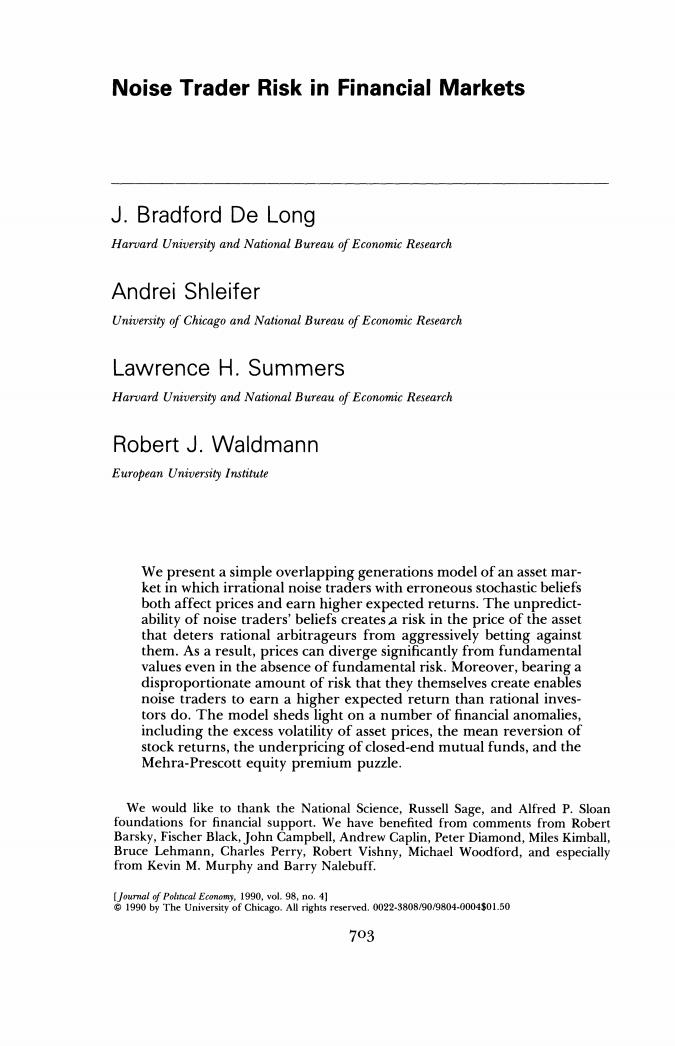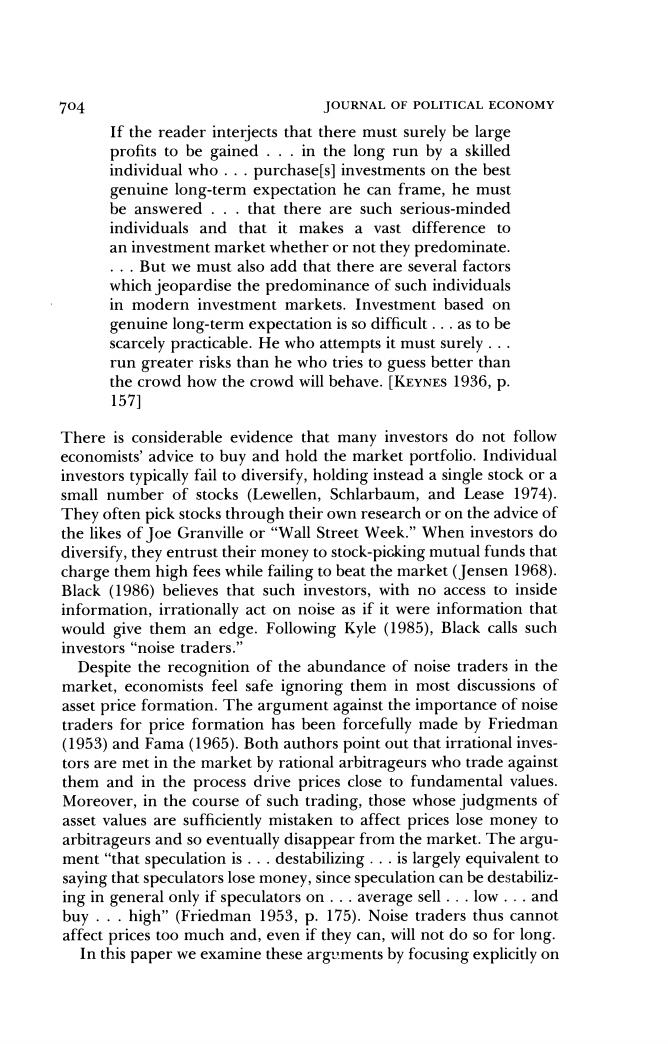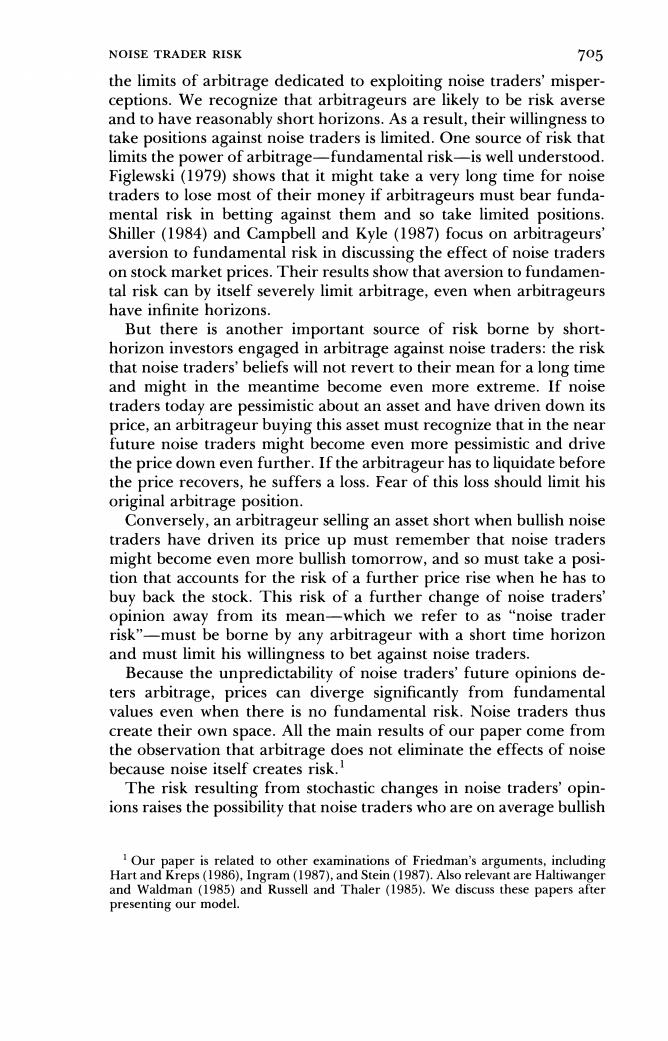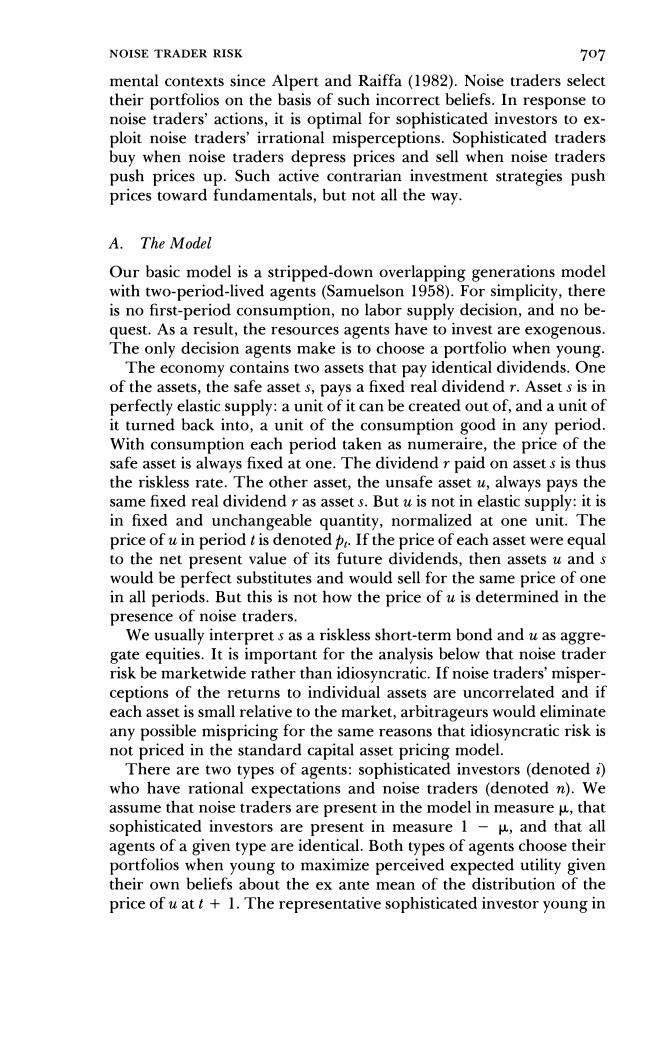
Noise Trader Risk in Financial Markets J.Bradford De Long Harvard University and National Bureau of Economic Research Andrei Shleifer University of Chicago and National Bureau of Economic Research Lawrence H.Summers Harvard University and National Bureau of Economic Research Robert J.Waldmann European University Institute We present a simple overlapping generations model of an asset mar- ket in which irrational noise traders with erroneous stochastic beliefs both affect prices and earn higher expected returns.The unpredict- ability of noise traders'beliefs creates a risk in the price of the asset that deters rational arbitrageurs from aggressively betting against them.As a result,prices can diverge significantly from fundamental values even in the absence of fundamental risk.Moreover,bearing a disproportionate amount of risk that they themselves create enables noise traders to earn a higher expected return than rational inves- tors do.The model sheds light on a number of financial anomalies, including the excess volatility of asset prices,the mean reversion of stock returns,the underpricing of closed-end mutual funds,and the Mehra-Prescott equity premium puzzle. We would like to thank the National Science,Russell Sage,and Alfred P.Sloan foundations for financial support.We have benefited from comments from Robert Barsky,Fischer Black,John Campbell,Andrew Caplin,Peter Diamond,Miles Kimball, Bruce Lehmann,Charles Perry,Robert Vishny,Michael Woodford,and especially from Kevin M.Murphy and Barry Nalebuff. [Journal of Polncal Economy,1990.vol.98,no.4] 1990 by The University of Chicago.All rights reserved.0022-3808/90/9804-0004$01.50 703

704 JOURNAL OF POLITICAL ECONOMY If the reader interjects that there must surely be large profits to be gained...in the long run by a skilled individual who...purchase[s]investments on the best genuine long-term expectation he can frame,he must be answered...that there are such serious-minded individuals and that it makes a vast difference to an investment market whether or not they predominate. ..But we must also add that there are several factors which jeopardise the predominance of such individuals in modern investment markets.Investment based on genuine long-term expectation is so difficult...as to be scarcely practicable.He who attempts it must surely... run greater risks than he who tries to guess better than the crowd how the crowd will behave.[KEYNES 1936,p. 157] There is considerable evidence that many investors do not follow economists'advice to buy and hold the market portfolio.Individual investors typically fail to diversify,holding instead a single stock or a small number of stocks (Lewellen,Schlarbaum,and Lease 1974). They often pick stocks through their own research or on the advice of the likes of Joe Granville or "Wall Street Week."When investors do diversify,they entrust their money to stock-picking mutual funds that charge them high fees while failing to beat the market(Jensen 1968). Black (1986)believes that such investors,with no access to inside information,irrationally act on noise as if it were information that would give them an edge.Following Kyle (1985),Black calls such investors "noise traders." Despite the recognition of the abundance of noise traders in the market,economists feel safe ignoring them in most discussions of asset price formation.The argument against the importance of noise traders for price formation has been forcefully made by Friedman (1953)and Fama(1965).Both authors point out that irrational inves- tors are met in the market by rational arbitrageurs who trade against them and in the process drive prices close to fundamental values. Moreover,in the course of such trading,those whose judgments of asset values are sufficiently mistaken to affect prices lose money to arbitrageurs and so eventually disappear from the market.The argu- ment"that speculation is...destabilizing...is largely equivalent to saying that speculators lose money,since speculation can be destabiliz- ing in general only if speculators on...average sell...low...and buy...high"(Friedman 1953,p.175).Noise traders thus cannot affect prices too much and,even if they can,will not do so for long. In this paper we examine these arguments by focusing explicitly on

NOISE TRADER RISK 705 the limits of arbitrage dedicated to exploiting noise traders'misper- ceptions.We recognize that arbitrageurs are likely to be risk averse and to have reasonably short horizons.As a result,their willingness to take positions against noise traders is limited.One source of risk that limits the power of arbitrage-fundamental risk-is well understood. Figlewski(1979)shows that it might take a very long time for noise traders to lose most of their money if arbitrageurs must bear funda- mental risk in betting against them and so take limited positions. Shiller(1984)and Campbell and Kyle (1987)focus on arbitrageurs aversion to fundamental risk in discussing the effect of noise traders on stock market prices.Their results show that aversion to fundamen- tal risk can by itself severely limit arbitrage,even when arbitrageurs have infinite horizons. But there is another important source of risk borne by short- horizon investors engaged in arbitrage against noise traders:the risk that noise traders'beliefs will not revert to their mean for a long time and might in the meantime become even more extreme.If noise traders today are pessimistic about an asset and have driven down its price,an arbitrageur buying this asset must recognize that in the near future noise traders might become even more pessimistic and drive the price down even further.If the arbitrageur has to liquidate before the price recovers,he suffers a loss.Fear of this loss should limit his original arbitrage position. Conversely,an arbitrageur selling an asset short when bullish noise traders have driven its price up must remember that noise traders might become even more bullish tomorrow,and so must take a posi- tion that accounts for the risk of a further price rise when he has to buy back the stock.This risk of a further change of noise traders' opinion away from its mean-which we refer to as "noise trader risk"-must be borne by any arbitrageur with a short time horizon and must limit his willingness to bet against noise traders. Because the unpredictability of noise traders'future opinions de- ters arbitrage,prices can diverge significantly from fundamental values even when there is no fundamental risk.Noise traders thus create their own space.All the main results of our paper come from the observation that arbitrage does not eliminate the effects of noise because noise itself creates risk. The risk resulting from stochastic changes in noise traders'opin- ions raises the possibility that noise traders who are on average bullish Our paper is related to other examinations of Friedman's arguments,including Hart and Kreps(1986),Ingram(1987),and Stein(1987).Also relevant are Haltiwanger and Waldman (1985)and Russell and Thaler (1985).We discuss these papers after presenting our model

706 JOURNAL OF POLITICAL ECONOMY earn a higher expected return than rational,sophisticated investors engaged in arbitrage against noise trading.This result obtains be- cause noise trader risk makes assets less attractive to risk-averse arbi- trageurs and so drives down prices.If noise traders on average over- estimate returns or underestimate risk,they invest more in the risky asset on average than sophisticated investors and may earn higher average returns.This result is more interesting than the point that if noise traders bear more fundamental risk they earn higher returns: our point is that noise traders can earn higher expected returns solely by bearing more of the risk that they themselves create.Noise traders can earn higher expected returns from their own destabilizing in- fluence,not because they perform the useful social function of bear- ing fundamental risk. Our model also has several implications for asset price behavior. Because noise trader risk limits the effectiveness of arbitrage,prices in our model are excessively volatile.If noise traders'opinions follow a stationary process,there is a mean-reverting component in stock returns.Our model also shows how assets subject to noise trader risk can be underpriced relative to fundamental values.We apply this idea to explain the underpricing of closed-end mutual funds,as well as the long-run underpricing of stocks known as the Mehra-Prescott(1985) puzzle.Finally,our model has several implications for the optimal investment strategy of sophisticated investors and for the possible role of long-term investors in stabilizing asset prices. We develop our two main arguments-that bearing noise trader risk raises noise traders'returns and that noise trader risk can explain several financial anomalies-in five sections.Section I presents a model of noise trader risk and shows how prices can diverge signifi- cantly from fundamental values.Section II calculates the relative ex- pected returns of noise traders and of sophisticated investors.Section III analyzes the persistence of noise traders in an extended model in which successful investors are imitated (as in Denton [1985]).Section IV presents qualitative implications of the model for the behavior of asset prices and market participants.Section V presents conclusions. I.Noise Trading as a Source of Risk The model contains noise traders and sophisticated investors.Noise traders falsely believe that they have special information about the future price of the risky asset.They may get their pseudosignals from technical analysts,stockbrokers,or economic consultants and irration- ally believe that these signals carry information.Or in formulating their investment strategies,they may exhibit the fallacy of excessive subjective certainty that has been repeatedly demonstrated in experi-

NOISE TRADER RISK 707 mental contexts since Alpert and Raiffa(1982).Noise traders select their portfolios on the basis of such incorrect beliefs.In response to noise traders'actions,it is optimal for sophisticated investors to ex- ploit noise traders'irrational misperceptions.Sophisticated traders buy when noise traders depress prices and sell when noise traders push prices up.Such active contrarian investment strategies push prices toward fundamentals,but not all the way. A.The Model Our basic model is a stripped-down overlapping generations model with two-period-lived agents(Samuelson 1958).For simplicity,there is no first-period consumption,no labor supply decision,and no be- quest.As a result,the resources agents have to invest are exogenous. The only decision agents make is to choose a portfolio when young. The economy contains two assets that pay identical dividends.One of the assets,the safe assets,pays a fixed real dividendr.Asset s is in perfectly elastic supply:a unit of it can be created out of,and a unit of it turned back into,a unit of the consumption good in any period. With consumption each period taken as numeraire,the price of the safe asset is always fixed at one.The dividend r paid on asset s is thus the riskless rate.The other asset,the unsafe asset u,always pays the same fixed real dividend r as asset s.But u is not in elastic supply:it is in fixed and unchangeable quantity,normalized at one unit.The price of u in period t is denoted If the price of each asset were equal to the net present value of its future dividends,then assets u and s would be perfect substitutes and would sell for the same price of one in all periods.But this is not how the price of u is determined in the presence of noise traders. We usually interpret s as a riskless short-term bond and u as aggre- gate equities.It is important for the analysis below that noise trader risk be marketwide rather than idiosyncratic.If noise traders'misper- ceptions of the returns to individual assets are uncorrelated and if each asset is small relative to the market,arbitrageurs would eliminate any possible mispricing for the same reasons that idiosyncratic risk is not priced in the standard capital asset pricing model. There are two types of agents:sophisticated investors(denoted i) who have rational expectations and noise traders (denoted n).We assume that noise traders are present in the model in measure u,that sophisticated investors are present in measure 1 -H,and that all agents of a given type are identical.Both types of agents choose their portfolios when young to maximize perceived expected utility given their own beliefs about the ex ante mean of the distribution of the price of u at t 1.The representative sophisticated investor young in